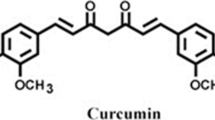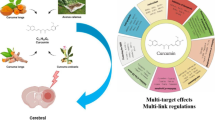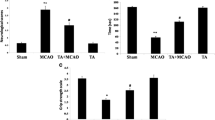Abstract
Turmeric has been in use since ancient times as a condiment and due to its medicinal properties. Curcumin, the yellow colouring principle in turmeric, is polyphenolic and major active constituent. Besides anti-inflammatory, thrombolytic and anticarcinogenic activities, curcumin also possesses strong antioxidant property. In view of the novel combination of properties, neuroprotective efficacy of curcumin was studied in rat middle cerebral artery occlusion (MCAO) model. Rats were subjected to 2 h of focal ischemia followed by 72 h of reperfusion. They were pre-treated with curcumin (100 mg/kg, po) for 5 days prior to MCAO and for another 3 days after MCAO. The parameters studied were behavioural, biochemical and histological. Treatment with curcumin could significantly improve neurobehavioral performance compared to untreated ischemic rats as judged by its effect on rota-rod performance and grid walking. A significant inhibition in lipid peroxidation and an increase in superoxide dismutase (SOD) activity in corpus striatum and cerebral cortex was observed following treatment with curcumin in MCAO rats as compared to MCAO group. Intracellular calcium levels were decreased following treatment with curcumin in MCAO rats. Histologically, a reduction in the infarct area from 33% to 24% was observed in MCAO rats treated with curcumin. The study demonstrates the protective efficacy of curcumin in rat MCAO model.




Similar content being viewed by others
References
Rogers DC, Campbell CA, Jennifer L, Stretton L, Macky KB (1997) Correlation between motor impairment and infarct volume after permanent and transient middle artery occlusion in rat. Stroke 28:2060–2065
Castillo J, Rama R, Davalos A (2000) Nitric oxide-related brain damage in ischemic stroke. Stroke 31:852–857
Chabrier P, Auguet M, Spinnewyn B, Auvin S, Cornet S, Demerle-Pallardy C, Guilmard-favre C, Marin J, Pignol B, Gillard-Roubrt V, Roussillot-Charnet C, Schulz J, Viossat I, Bigg D, Moncada S (1999) BN 80933, a dual inhibitor of neuronal nitric oxide synthase and lipid peroxidation: a promising neuroprotective strategy. Proc Natl Acad Sci 96:10824–10829
Tortella FC, Britton P, Williams A, May C, Newman AH (1999) Neuroprotection (focal ischemia) and neurotoxicity (electro-encephalographic) studies in rats with AHN649, a 3-amino analogue of dextromethorphan and low-affinity N-methyl-D-aspartate antagonist. J Pharmacol Exp Ther 291:399–408
Vemuganti R, Dempsey RJ, Bowen KK (2004) Inhibition of intercellular adhesion molecule-1 protein expression by antisense oligonucleotides is neuroprotective after transient middle cerebral artery occlusion in rat. Stroke 35:179–184
Wang Y, Chang CF, Chen HL, Deng X, Harvey BK, Cadet JL, Bickford PC (2005) Dietary supplementation with blueberries, spinach or spirulina reduces ischemic brain damage. Exp Neurol 193:75–84
Hara H, Kato H, Kogure K (1990) α-tocopherol on ischemic neuronal damage in the gerbil hippocampus. Brain Res 510:335–338
Gong X, Sucher NJ (1999) Stroke therapy in traditional Chinese medicine (TCM): prospects for drug discovery and development. Trends Pharmacol Sci 20:191–198
Pierre S, Jamme I, Droy-Lefaix MT, Nauvelot A, Maixent JM (1999) Ginko biloba (EGb 761) protects Na+, K+ ATPase activity during cerebral ischemia in mice. Neuroreport 10:47–51
Mokudai T, Ayoub IA, Sakakibara Y, Lee E-J, Ogilvy CS, Maynard KI (2000) Delayed treatment with nicotinamide (Vitamin B3) improves neurological outcome and reduces infarct volume after transient focal cerebral ischemia in Wistar rat. Stroke 31:1679–1685
Sivananda S (1958) Home remedies, the yoga. Vedanta University, Sivanand Nagar, India, pp 334–335
Nadkarni KM, Nadkarni AK (1976) Indian materia medica, 1. Popular Prakashan Private Ltd., Bombay
Raghunath K, Mitra R (1982) Pharmacognosy of indigenous drugs, 1. Central Council for Research in Ayurveda and Siddha, New Delhi, pp 376–392
Dash VP (1987) Illustrated materia medica of Indo-Tibetan medicine. Classic India Publication, Delhi, pp 334–335
Srimal RC, Dhawan BN (1973) Pharmacology of diferuloyl methane (Curcumin) a non-steroidal anti-inflammatory agent. J Pharm Pharmacol 25:447–452
Ghatak N, Basu N (1972) Sodium curcuminate as an effective anti-inflammatory agent. Ind J Exp Biol 10:235–236
Rao TS, Basu N, Seth SD, Siddiqui HH (1984) Some aspect of pharmacological profile of sodium curcuminate. Ind J Physiol Pharmacol 28:211–215
Srimal RC (1997) Turmeric: a brief review of medicinal properties. Fitoterapia LXVIII (6):483–493
Ammon HPT, Wahl MA (1991) Pharmacology of Curcuma longa. Planta Med 57:1–7
Sharma OP (1976) Antioxidant activity of curcumin and related compounds. Biochem Pharmacol 25:1811–1812
Maheshwari RK, Singh AK, Gaddipati J, Srimal RC (2006) Multiple biological activities of Curcumin: a short review. Life Sci 78:2081–2087
Aggarwal BB, Kumar A, Aggarwal MS, Sishodia S (2005) Curcumin derived from turmeric (Curcuma longa): a spice for all seasons. In: Phytopharmaceuticals in cancer chemoprevention, CRC Press, pp 349–387
Lal B, Kapoor AK, Asthana OP, Agrawal PK, Prasad R, Kumar P, Srimal RC (1999) Efficacy of curcumin in the management of chronic anterior uveitis. Phytother Res 13:318–322
Egan E, Pearson M, Weiner SA, Rajendran V, Rubin D, Glöckner-Pagel J, Canny S, Kai Du, Lukacs GL, Caplan MJ (2004) Curcumin, a major constituent of turmeric, corrects cystic fibrosis defects. Science 304:600–602
Kumar P, Padi SS, Naidu PS, Kumar A (2007) Possible neuroprotective mechanisms of curcumin in attenuating 3-nitropropionic acid induced neurotoxicity. Methods Find Exp Clin Pharmacol 29:19–25
Dairam A, Limson JL, Watkins GM, Antunes E, Daya S (2007) Curcuminoids, curcumin and demethoxycurcumin reduce lead induced memory deficits in male Wistar rats. J Agric Food Chem 55:1039–1044
Pari L, Murugan P (2007) Tetrahydrocurcumin prevents brain lipid peroxidation in streptozotacin induced diabetic rats. J Med Food 10:323–329
Yang F, Lim GP, Begum AN, Ubeda OJ, Simmons MR, Ambegaokar SS, Chen PP, Kayed R, Glabe CG, Frautschy SA, Cole GM (2005) Curcumin inhibits formation of amyloid beta oligomers and fibrils, binds plaques and reduces amyloid in vivo. J Biol Chem 280:5892–5901
Thiyagarajan M, Sharma SS (2004) Neuroprotective effect of curcumin in middle cerebral artery occlusion induced focal cerebral ischemia in rats. Life Sci 74:969–985
Srimal RC, Shukla PK, Ali MM, Khanna VK (2003) Protective effect of curcumin and Acorus calamus against chemical induced neurotoxicity and middle cerebral artery occlusion in rat. Invited paper at International Symposium on Molecular Toxicology and Environmental Health, November 5–8, Lucknow, India
Longa EZ, Weinstein PR, Carlson S, Cummins R (1989) Reversible middle cerebral artery occlusion without craniotomy in rats. Stroke 20:84–91
Glowinski J, Iverson LL (1966) Regional studies of catecholamines in the rat brain. The deposition of 3H-norepinephrine, 3H-dopamine, and 3H-dopa in various regions of the brain. J Neurochem 13:655–659
Bohme DH, Kosechzi R, Carsen S, Stern F, Marks N (1977) Lipid peroxidation in human and rat brain tissue: developmental and regional studies. Brain Res 136:11–21
Kakkar P, Das B, Viswanathan PN (1984) A modified spectrophotometric assay of superoxide dismutase. Indian J Biochem Biophys 21:130–132
Komulainen H, Bondy SC (1987) The estimation of free calcium within the synaptosomes in mitochondria with Fura-2; comparison to Quin-2. Neurochem Int 10:55–64
Lowry OH, Rosebrough NJ, Forr AL, Randall R (1951) Protein measurement with the Folin phenol reagent. J Biol Chem 193:265–275
Callaway JK, Knight MJ, Watkins DJ, Beart PM, Jarrott BJ (1999) Delayed treatment with AM-36, a novel neuroprotective agent, reduces neuronal damage after endothelin-1-induced middle cerebral artery occlusion in conscious rats. Stroke 30:2704–2712
Vakili A, Zahedi Khorasani M (2007) Post-ischemic treatment of pentoxifyline reduces cortical not striatal infarct volume in transient model of focal cerebral ischemia in rat. Brain Res 1144:186–191
Kinouchi H, Epstein CJ, Mizui T, Carlson EJ, Chen SF, Chan PH (1991) Attenuation of focal cerebral ischemic injury in transgenic mice over expressing CuZn superoxide dismutase. Proc Natl Acad Sci 88:11158–11162
Kuroda S, Siesjo BK (1997) Reperfusion damage following focal ischemia: pathophysiology and therapeutic windows. Clin Neurosci 4:199–212
Gracia JH, Liu FN (1996) Brain parenchymal responses to experimental focal ischemia: cellular inflammation. In: Krieglstein J (ed) Pharmacology of cerebral ischemia. Medpharm Scientific Publisher, Stuttgart, pp 379–384
Curtis-Prior P, Vere D, Fray P (1999) Therapeutic value of Ginko biloba in reducing symptoms of decline in mental function. J Pharm Pharmacol 51:535–541
De Keyser J, Sulter G, Luiten PG (1999) Clinical trials with neuroprotective drugs in acute ischemic stroke: are we doing right thing. Trends Neurosci 22:535–540
Huh PW, Belayev L, Zhao W, Clemens JA, Paneeta JA, Busto R, Ginsberg MD (2000) Neuroprotection by LY341122, a novel inhibitor of lipid peroxidation, against focal ischemia brain damage in rat brain. Eur J Pharmacol 389:79–88
Srivastava R, Dikshit M, Srimal RC, Dhawan BN (1985) Antithrombotic effect of curcumin. Thromb Res 40:413–418
Motterlini R, Foresti R, Bassi R, Green CC (2000) Curcumin, an antioxidant and anti-inflammatory agent, induces heme oxygenase-1 and protects endothelial cells against oxidative stress. Free Radic Biol Med 28:1303–1312
Priyadarsini KI (1997) Free radical reaction of curcumin in membrane model. Free Radic Biol Med 21:838–843
Soudamini KK, Unnikrishnan MC, Soni KB, Kuttan R (1992) Inhibition of lipid peroxidation and cholesterol levels in mice by curcumin. Indian J Physiol Pharmacol 36:239–243
Shukla PK, Khanna VK, Khan MY, Srimal RC (2003) Protective effect of curcumin against lead neurotoxicity in rat. Hum Exp Toxicol 22:653–658
Pan MH, Huang TM, Lin JK (1999) Biotransformation of curcumin through reduction and glucuronidation in mice. Drug Metabo Dispos 27:486–494
Lin JK, Shih CA (1994) Inhibitory effect of curcumin on xanthine dehydrogenase/oxidase induced by phorbol-1,2-myristate-13-acetate in NIH3T3 cells. Carcinogenesis 15:1717–1721
Wang Q, Sun AY, Simonyi A, Jensen MD, Shealt PB, Rottinghaus GE, MacDonald RS, Miller DK, Lubhan DE, Weisman GA, Sun GY (2005) Neuroprotective mechanisms of curcumin against cerebral ischemia induced neuronal apoptosis and behavioural deficits. J Neurosci Res 82:138–148
Sharma SC, Mukhtar H, Sharma SK, Krishna Murti CR (1972) Lipid peroxide formation in experimental inflammation. Biochem Pharmacol 21:1210–1214
Barone FC, Feuerstein GZ, Spera RP (1997) Calcium channel blockers in cerebral ischaemia. Expert Opin Investig Drugs 6:501–519
Matteucci A, Frank C, Domenici MR, Balduzzi M, Paradisi S, Carnovale-Scalzo G, Scorcia G, Malchiodi-Albedi F (2005) Curcumin treatment protects rat retinal neurons against excitotoxicity: effect on N-methyl-D-Aspartate induced intracellular calcium increase. Exp Brain Res 167:641–648
Acknowledgements
The study was supported by a grant from the Council of Scientific and Industrial Research, New Delhi. The authors acknowledge the technical assistance of M/S. Kanhiya Lal and Buddhi Sagar Pandey.
Author information
Authors and Affiliations
Corresponding author
Rights and permissions
About this article
Cite this article
Shukla, P.K., Khanna, V.K., Ali, M.M. et al. Anti-ischemic Effect of Curcumin in Rat Brain. Neurochem Res 33, 1036–1043 (2008). https://doi.org/10.1007/s11064-007-9547-y
Received:
Accepted:
Published:
Issue Date:
DOI: https://doi.org/10.1007/s11064-007-9547-y




